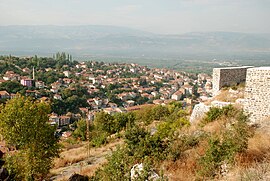Niksar
This article needs additional citations for verification. (March 2013) |
Niksar | |
|---|---|
 Niksar view from the city center | |
| Coordinates: 40°35′30″N 36°57′06″E / 40.59167°N 36.95167°E | |
| Country | Turkey |
| Province | Tokat |
| District | Niksar |
| Government | |
| • Mayor | Özdilek Özcan (AKP) |
| Population (2022)[1] | 37,017 |
| Time zone | UTC+3 (TRT) |
| Postal code | 60600 |
| Area code | 0356 |
| Website | www |
Niksar, historically known as Neocaesarea (Νεοκαισάρεια), is a city in Tokat Province, Turkey. It is the seat of Niksar District.[2] Its population is 37,017 (2022).[1] It was settled by many empires. Niksar is known as "Çukurova of North-Anatolia" due to its production of many kinds of fruits and vegetables. On May 2, 2018, Niksar was included in the World Heritage tentative list.[3]
History
Niksar has been ruled by the
It was known as
In 72 or 71 BCE, the
During the Middle Ages, the Muslims and Christians disputed the possession of Neocaesarea, and in 1068 a
In 1100, Bohemond I of Taranto was held prisoner in Niksar castle until 1103.[9]
By 1175, during the reign of
Ecclesiastical history
Neocaesarea was an episcopal see in the late Roman province of
Bishops

Noted bishops include Saints Gregory Thaumaturgus, Paul of Neocaesarea, and Thomas, a 9th-century martyr.
Gregory of Nyssa claimed that about 240, when Gregory Thaumaturgus was consecrated bishop of his native city, Neocæsarea had only seventeen Christians and that at his death (270) it counted only seventeen pagans.[12] In 315 a great council was held there, the acts of which are still extant. In the early church baptism was generally by immersion. Baptism by perfusion, that is by pouring the water over the candidate, was permitted in the case of the seriously ill and where sufficient water for immersion was unobtainable or impractical, as in, for example, prisons. The Council of Neocaesarea ruled that individuals baptized by perfusion were disqualified from being presbyters. This became an issue in the case of Novatian, who had received baptism by perfusion when dangerously ill.[13]
Being early placed at the head of an ecclesiastical province, Neocæsarea had four suffragan sees about 640 ("Ecthesis" of pseudo-Epiphanius, ed.
Geographic location
Niksar is approximately 9,555 km2 (3,689 sq mi). It is located at 40°35' north latitude and 36°58' east longitude. Its average altitude is 350 m above sea level. It is surrounded by Erbaa on the northwest, Tokat on the southwest, Almus on the south, Başçiftlik on the southeast and Akkuş on the north. It is one of the five largest counties of Tokat.[citation needed] The Canik Mountains are to the north, Dönek Mountain to the south, and the Niksar Lowland is situated between these mountains. The Niksar Lowland is one of the most important lowlands of the Black Sea Region.[citation needed] The Canik Mountains are covered with plateaus that lie parallel to the Black Sea. Çamiçi High Plateau is one of the most important ones.[why?]
Niksar lands are irrigated by large and small tributaries of the Kelkit River. Forests cover 53% of the plateau, and pasture 12%; 32% of the land is devoted to agriculture, and only 3% is unsuitable for farming. Beech, pine, horn beech, and spruce trees can be found in the higher altitudes to the north of Niksar. In the lowlands there are poplar and willow trees, and fruit trees in the valleys. Polecats, rabbits, wolves, foxes, lynxes, bears, and pigs are the main hunting animals that live in the mountains and forests. Partridges, quail and ducks are among the more important game birds found here. Niksar has a transitional oceanic climate and continental climate. It is generally cold and snowy in winter, and hot and moderately dry in summer.
Cuisine of Niksar

The most remarkable feature of traditional Tokat-Niksar houses is the kitchen. Called Aşevi or Aşgana in the local dialect, the kitchen is usually the largest room of the house and serves as a sort of lounge for the family. The typical kitchen has a fireplace on one side used for cooking or washing and a storeroom on the other in which dried foods, preserves, sauces, cheese and grape leaves are kept. Beside the storeroom is a wooden granary with partitions for storing cereals and legumes. In Turkey, it is common to eat meals around a low table.
The famous local foods of Niksar are walnut, tomato paste and grape leaves which is a main ingredient of dolma, a very popular dish in Turkey.
Places of interest
References
- ^ TÜİK. Retrieved 22 May 2023.
- ^ İlçe Belediyesi, Turkey Civil Administration Departments Inventory. Retrieved 22 May 2023.
- ^ "Early Period of Anatolian Turkish Heritage: Niksar, The Capital of Danishmend Dynasty". UNESCO World Heritage Centre. Retrieved 14 July 2018.
- ^ a b Stillwell, Richard; MacDonald, William L.; McAllister, Marian Holland, eds. (1976). "Neocaesarea". The Princeton Encyclopedia of Classical Sites. Princeton University Press.
- ^ a b Catholic Encyclopedia, 1907, s.v. Neocaesarea
- ^ Jerome, Chronicle, anno 2362
- ^ Theodorus Lector, II, 54
- ^ Beihammer 2017, pp. 210–212.
- ^ [[[Bohemond I of Antioch]] "Bohemond I of Antioch"].
{{cite web}}: Check|url=value (help) - ISBN 978-0-907132-32-5.
- ISBN 978-88-209-9070-1), p. 939
- ISBN 978-0-8122-3738-2. Retrieved 16 April 2015.
- ^ "Sacraments of the Orthodox Church", The Church Eclectic, 1901
Bibliography
 This article incorporates text from a publication now in the public domain: Herbermann, Charles, ed. (1913). "Neocæsarea (2)". Catholic Encyclopedia. New York: Robert Appleton Company. The entry cites:
This article incorporates text from a publication now in the public domain: Herbermann, Charles, ed. (1913). "Neocæsarea (2)". Catholic Encyclopedia. New York: Robert Appleton Company. The entry cites:
- William Smith, Dictionary of Greek and Roman Geography (London, 1870), I, 462, II, 418, s. v. Cabira and Neocaesareia;
- OCLC 955922585.
- CUINET, La Turquie d'Asie, I (Paris, 1892), 733-35;
- CUMONT, Studia Pontica

